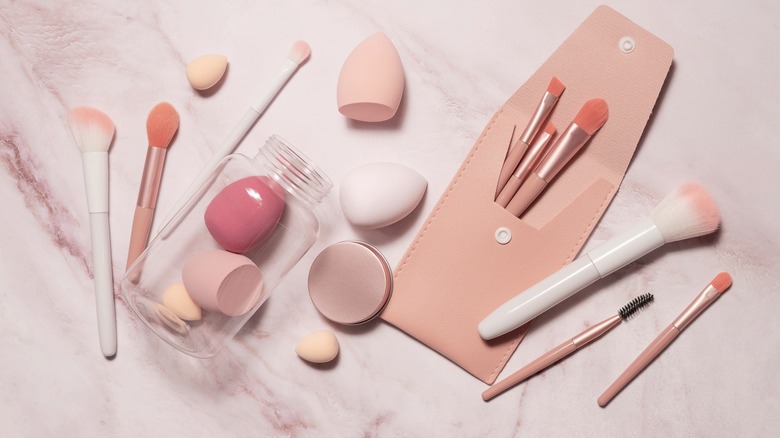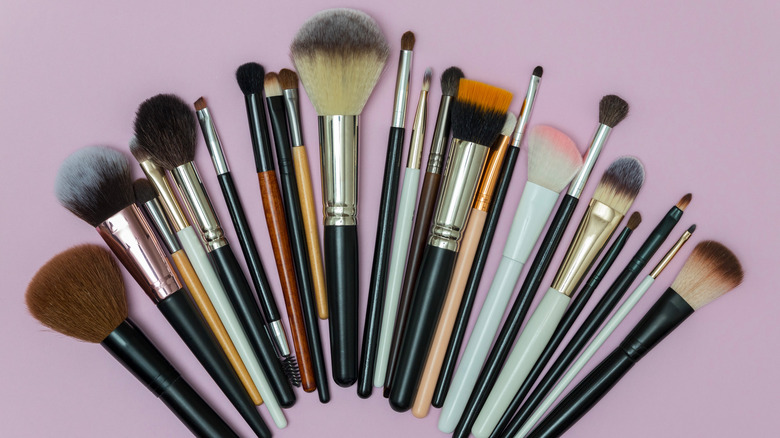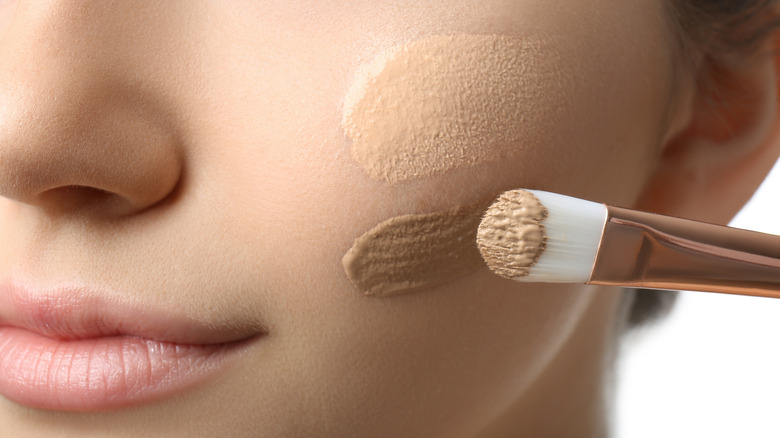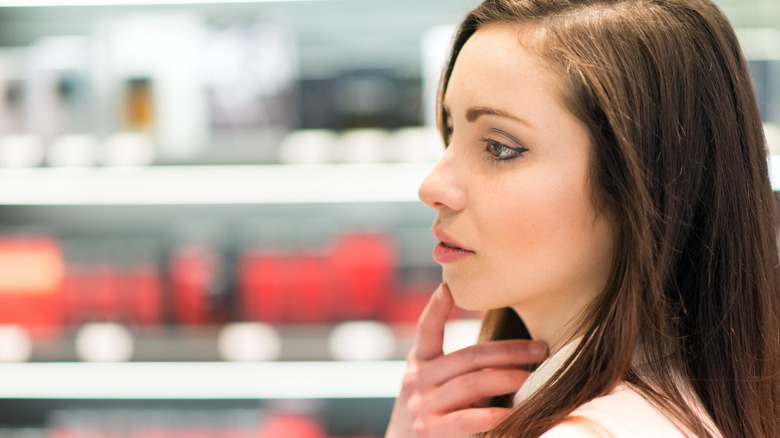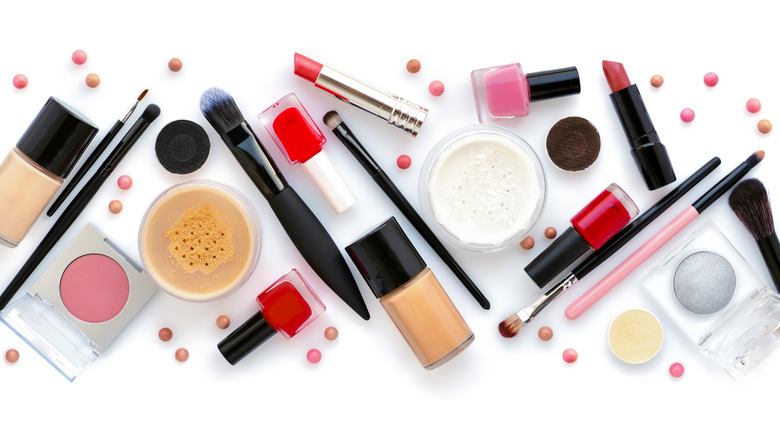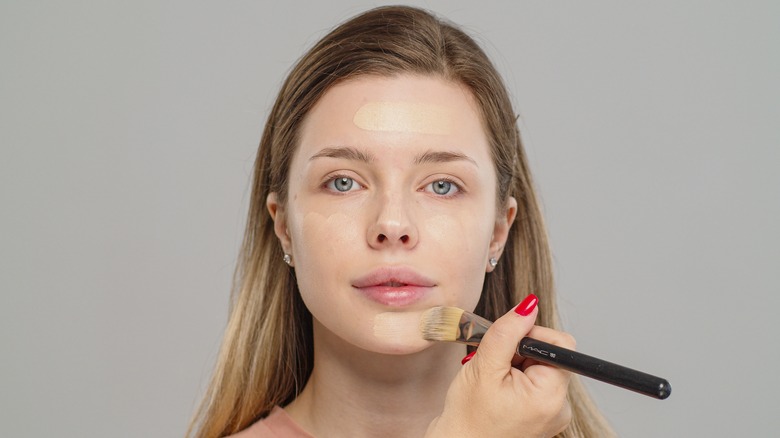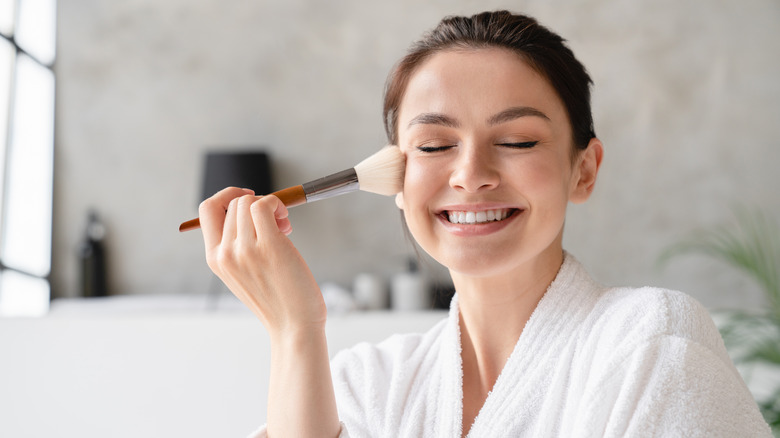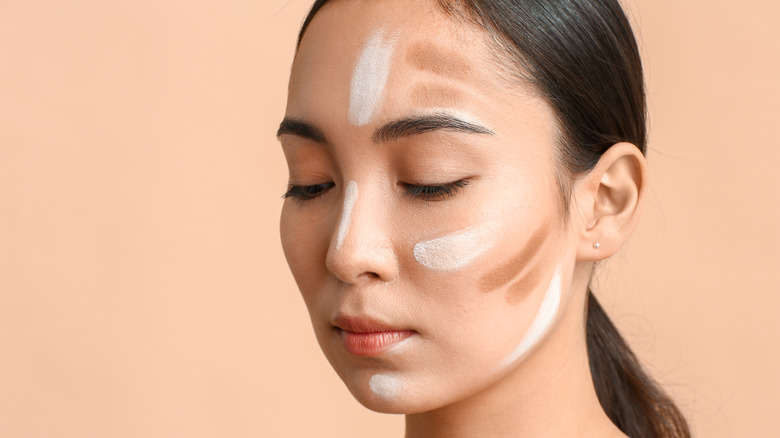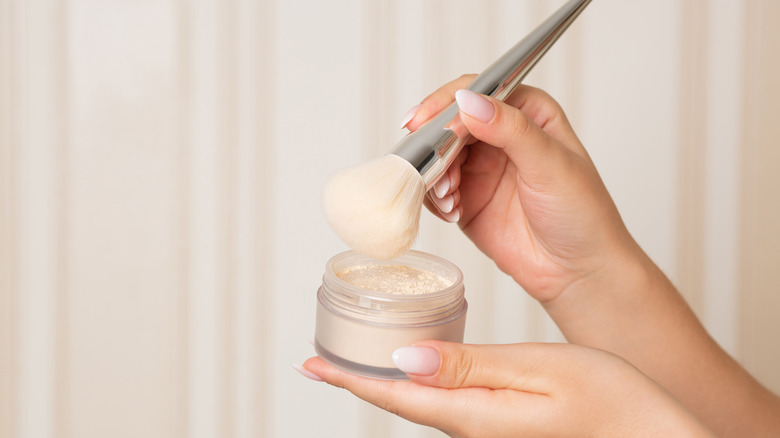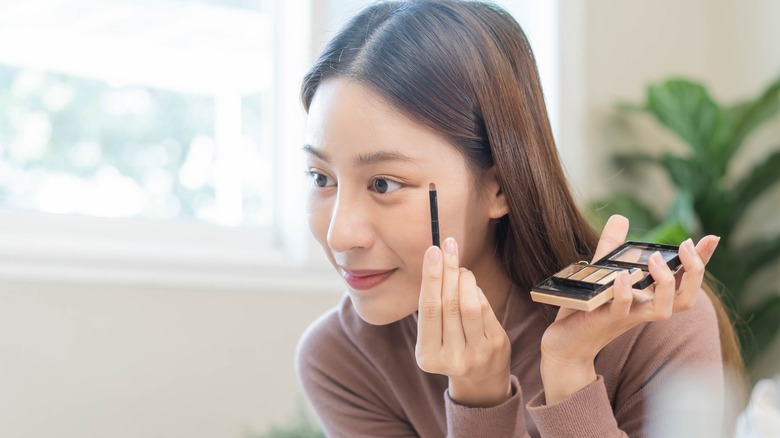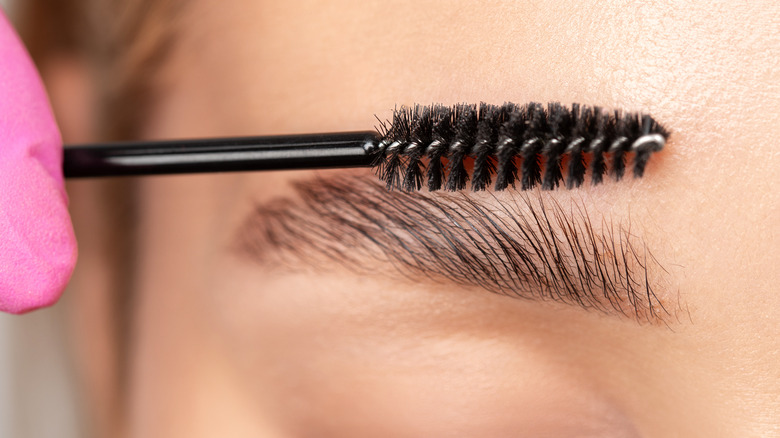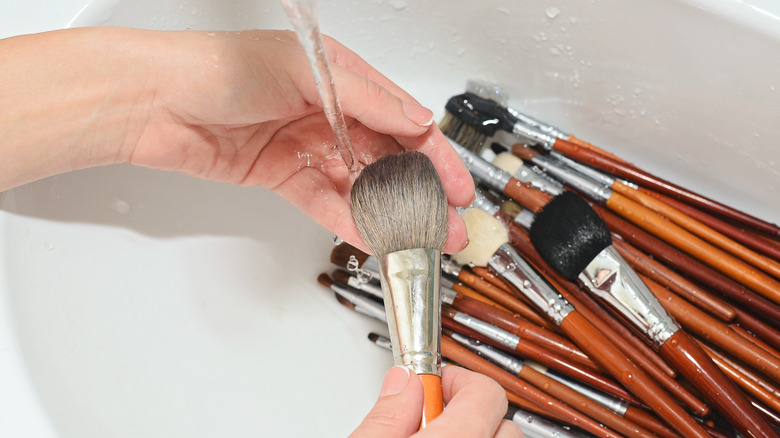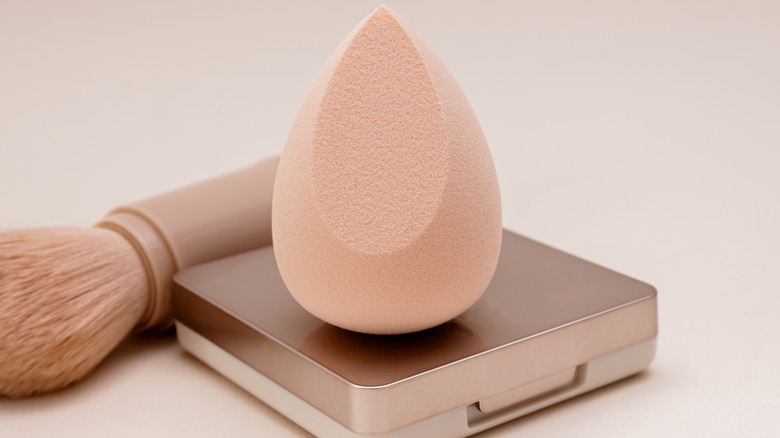The Ultimate Guide To Makeup Brushes And How To Use Them
The makeup industry continues to be an area where people are choosing to spend their money. According to npd, beauty is the one discretionary spending industry they follow that has not only seen growth this year but "strong, double-digit growth." Thanks in part to social media influencers for giving consumers a front-row seat to the infinite number of new and legacy products on the market, people are spending more than ever before on their beauty purchases.
It's very exciting to try new makeup, but if you're not familiar with the tools needed to recreate your favorite TikTok influencer's flawless looks, you may be left disappointed. Makeup brushes have come a long way over the years and can be the key to creating everything from a fresh-faced daytime look to a dramatic smoky eye.
If you've ever found yourself staring at the makeup brush aisle and feeling overwhelmed, you're not alone. So how do you choose what you need? "When choosing your makeup brushes, always go with what feels good, followed by the application test," celebrity makeup artist and Laruce Beauty ambassador Janice Daoud told Real Simple. If you're still confused, we're here to break down the different types of makeup brushes and how to use them so you can feel confident the next time you're ready to make a beauty purchase.
Real vs synthetic hair
When it comes to buying makeup brushes you will have the choice between natural or synthetic hair bristles. According to makeup.com, natural hair brushes are made from animal hair, typically sable, squirrel, or goat, which tends to make these makeup brushes more expensive than their synthetic counterparts. Man-made materials like nylon, taklon, or polyester fibers are often used to make synthetic makeup brushes.
However, just because natural brushes cost more doesn't necessarily make them better than their synthetic counterparts. As L'Oréal Paris notes, both have their benefits, depending on the products you're using. They suggest natural hair brushes for powder products since they tend to absorb oil and synthetic brushes for liquid and cream makeup since they won't absorb oil and are easier to clean.
Your budget and personal preferences will impact whether you choose to purchase natural or synthetic makeup brushes or a combination of the two. With so many great brushes available for purchase, you have endless options to choose from to find something that works for your budget and your skin type.
What can you use makeup brushes for?
If you're new to makeup brushes, or your experience is limited to those tiny brushes that come when you buy a blush, it can be overwhelming to know where to start. The good news is most makeup brushes are labeled, making it easier to know what product to use them with. But just because you have bought a powder brush doesn't mean you can't get creative when using it.
Celebrity makeup artist Mario Dedivanovic, who is one of Kim Kardashian's longtime makeup artists and has his own line of synthetic makeup brushes sold at Sephora, explained to Allure that despite his brushes each being labeled for which products to use them with, that is simply a suggestion. "I don't use brushes just for one thing," he commented. "I honestly do use them for lots of other things, what they're not intended for."
It may be easier for a professional makeup artist to get creative when it comes to makeup application, so for those who aren't quite as confident with using makeup brushes, those labels do make things a bit easier. But, as you start to use different brushes you may find there are some you like more than others, and you don't have to limit their use to their pre-determined label.
How to pick a good makeup brush
It's easy to be overwhelmed with all the choices when it comes time to select a makeup brush. Stephanie Riley, a professional makeup artist in Los Angeles explained to Oprah Daily that when you are looking to purchase new brushes or update the ones you already have, you don't have to buy an excess of them. Although your budget will dictate which brushes you will choose from, she suggests that consumers also shouldn't get too hung up on price, and instead "focus on brushes that are dense, durable, and have soft bristles." She also added that longer-handled brushes tend to be easier to hold.
AntonyM Cosmetics agrees that a higher cost doesn't always equal better when it comes to the price of your makeup brush. Experts from the natural makeup company suggest inspecting your brushes for soft bristles that are held firmly in place, to prevent any shedding, and making sure the brush is the shape and size for what you need. Once you get used to using the basic brushes you can start adding more specialized brushes to your makeup kit.
The core group
Want to start adding some core brushes to your makeup bag, but don't know where to start? According to Nordstrom, seven different brushes act as the foundation for any flawless makeup look. First, a foundation brush ensures the perfect application of your base makeup layer. Second, a powder brush is ideal for loose powders applied after your foundation or any setting powder you may use. Next, you'll want to add a blush brush to add that perfect rosy glow. This can be used with either a powder blush or cream blush.
A concealer brush works great when you want to touch up any blemishes or imperfections, while a flat, shader brush is recommended for eyeshadow. A crease brush can help you create a more dramatic eye, while an eyebrow brush can help shape and tame your brows and truly complete your look. As an extra, Stylecaster also suggests a medium-sized, flat highlighter brush to apply and perfectly blend your highlighter if you're a fan of strobing.
How to use your foundation brush
The sort of foundation brush you're going to buy depends on what kind of foundation you use. If you use a powder foundation you'll opt for a wider brush with fluffier bristles, versus a brush with dense bristles and a narrower brush head for liquid foundation, according to Ipsy. Whatever product you choose, there are two different ways to apply it. You can either add the product to your face with your fingers first, then use your brush to blend it into your skin or apply the product directly using your brush.
Makeup icon Bobbi Brown explained via MasterClass that when applying a liquid foundation one should first put some on the back of the hand, then use their fingers to apply it on the face before taking your foundation brush to blend the product in small, circular motions. She says it's best to start with just a small amount because you can always go back and add more. When applying a powder foundation, you can dip your brush directly in the powder, ensuring the brush head is fully coated. Gently buff the powder onto your face in a circular motion.
How to use your blush brush
Your blush brush may look different depending on the kind of blush you use and how you like your blush to look. Nordstrom notes that if you like the look of rosy cheeks, a round brush will work best. If you prefer a more dramatic look, an angled brush may work better. Celebrity makeup artist Melissa Hurkman told Real Simple that whether you use a lighter-colored powder blush or something meant to stand out a little more, "the more fluffy, flexible, and soft the bristles are, the better it will be to blend and get a soft wash of color from any product."
To apply your blush, dip your brush into the powder and tap off any of the excess powder back into the container. MAC Cosmetics' global senior artist Dominic Skinner explained (via Instagram) that while many people like to apply blush on the apples of the cheeks, working upward towards the hairline, he prefers to apply his blush in the opposite direction. "By working blusher down, what happens is the brush hair flicks and just leaves a softer edge," he said.
How to use your contour brush
Contouring has become a huge part of makeup application in the last few years but it can also be a bit daunting if you've never done it before. A proper technique that includes using the correct brush is important to make sure your contour is properly blended and you aren't leaving the house with dark splotches on your face.
According to beauty brand Lamora, contouring is best done in three steps to achieve that gorgeous glow and sculpted look we all love. First, they suggest using a tapered highlighter contour brush to apply your highlighter under and between your eyes. Next, use a precision-angled contour brush to apply just a small amount of highlighter on your brow bone and the bridge of your nose using "soft, even strokes." Finally, a flat contour brush can be used to help sculpt your face. They suggest you "hold the brush at an angle to move with the natural slope of cheekbones and jawline in long sweeping motions, working from the inside of your face outwards."
How to use your powder brush
If you love to set your makeup using a finishing powder or simply like to use a powder on days you choose to wear minimal makeup, a larger, soft-bristled powder brush is a must-have. A brush with large, fluffy bristles helps you distribute your setting powder evenly on your face, avoiding that cakey look, according to Nordstrom. Makeup artists at the department store also suggest looking for a brush with slightly denser bristles if you prefer a powder foundation. Apply your powder starting near your nose, using your brush to buff smaller circles as you work your way toward your ears.
To apply, experts at Ipsy write that you'll want to swirl your powder brush into your powder, then tap to get rid of any excess. For a lighter, more natural look, apply the powder in a buffing motion "into your forehead, cheekbones, nose, jaw, and neck with firm but gentle circular motions." Make sure to blend any excess and then you are done.
How to use your eyeshadow brushes
There are a few different kinds of eyeshadow brushes you can buy, which can leave you scratching your head whether you're new to using brushes or more experienced. There are angled brushes and pencil brushes as well as brushes for smudging and contouring, brushes that are flat-shaped, brushes for application on your crease to give that perfect winged effect, and precision brushes.
If you're already exhausted by these choices, celebrity makeup artist and Laruce Beauty ambassador Janice Daoud explained to Real Simple how to pick the right eyeshadow brush for you. "The best and most necessary eye makeup brushes are small eye-detailed brushes," Daoud explained. "A small shadow brush (also known as a smudger brush) can add a highlighter on the inner corners of the eyes, smoke out the lower lash line with eyeshadow, or define the edges of your eyes."
Starting with a smaller shadow brush can help you achieve many looks, but that doesn't mean you can't add more specialized brushes to your makeup kit as needed or wanted. Each eyeshadow brush has a purpose and how you choose to wear your makeup can help determine which brushes you should be adding to your makeup arsenal.
How to use a spoolie brush
Like all makeup brushes, there are different eyebrow brushes you can use depending on what eyebrow looks you prefer. Eyebrow guru Anastasia Beverly Hills offers five different types of eyebrow brushes to help you achieve the brows of your dreams, each with a spoolie on the opposite end.
A spoolie is a small brush that you can use to help brush your eyebrows, give them shape, or blend product that has been applied. Not only can a spoolie help tame those random eyebrow hairs that like to stick out, but it also allows you to fill in any areas where you may have over-plucked or that are simply a little thin.
According to Anastasia Beverly Hills, the brand's spoolies can be used for everything from helping to blend the edges of a product after it is applied to the eyebrows, brushing your eyebrow hairs before applying any product, and helping blend the product into your eyebrows to give yourself natural looking finish.
How to clean your makeup brushes
Now that you've invested in makeup brushes, you'll want to take good care of them. After all, cleaning and storing your brushes properly will ensure they last a long time. One of the main reasons you need to clean your brushes is to prevent buildup that can cause breakouts and bacterial growth. "If you have dirty brushes, then you are applying dirt and bacteria onto your face," Flynn Pyykkonen, CEO and Founder of Makeup By Flynn Inc., explained to makeup.com.
You can use a branded makeup brush cleaner, micellar water, or, as Pyykkonen prefers, gentle dish soap to clean your brushes. The American Academy of Dermatology Association suggests cleaning your brushes every week or so, by first running the bristles under lukewarm water. Then, fill a bowl with lukewarm water and your cleaning agent of choice. Swirl your brushes in the mixture before rinsing them under running water. Repeat until the water runs clear. Lay your brushes flat to dry, preferably with the tips hanging off a counter. Don't dry your brushes by stacking them upright because this can cause the water to run down and affect the glue that is holding the bristles in place.
The difference between brushes and sponges
How you like to wear your makeup is a very personal decision, which makes how you like to apply your makeup just as personal. You've probably wondered what the difference between sponges and makeup brushes really is, especially when it comes to applying products like foundation.
According to The Beauty Editor, a brush can give you more professional looks, as long as you are using it correctly. "Depending on the brush and foundation it can go a little stripy, so you really need to focus on blending," they note, adding that a sponge "gives the most skin-like finish and pushes the product into the complexion [so that] the foundation doesn't sit on top so it appears more seamless and natural."
Applying your makeup in a way that makes you look like the best version of yourself often comes after experimenting with different tools. One thing that all professionals agree with is that proper use, care, and cleaning are important in ensuring a great application and the longevity of your tools.
